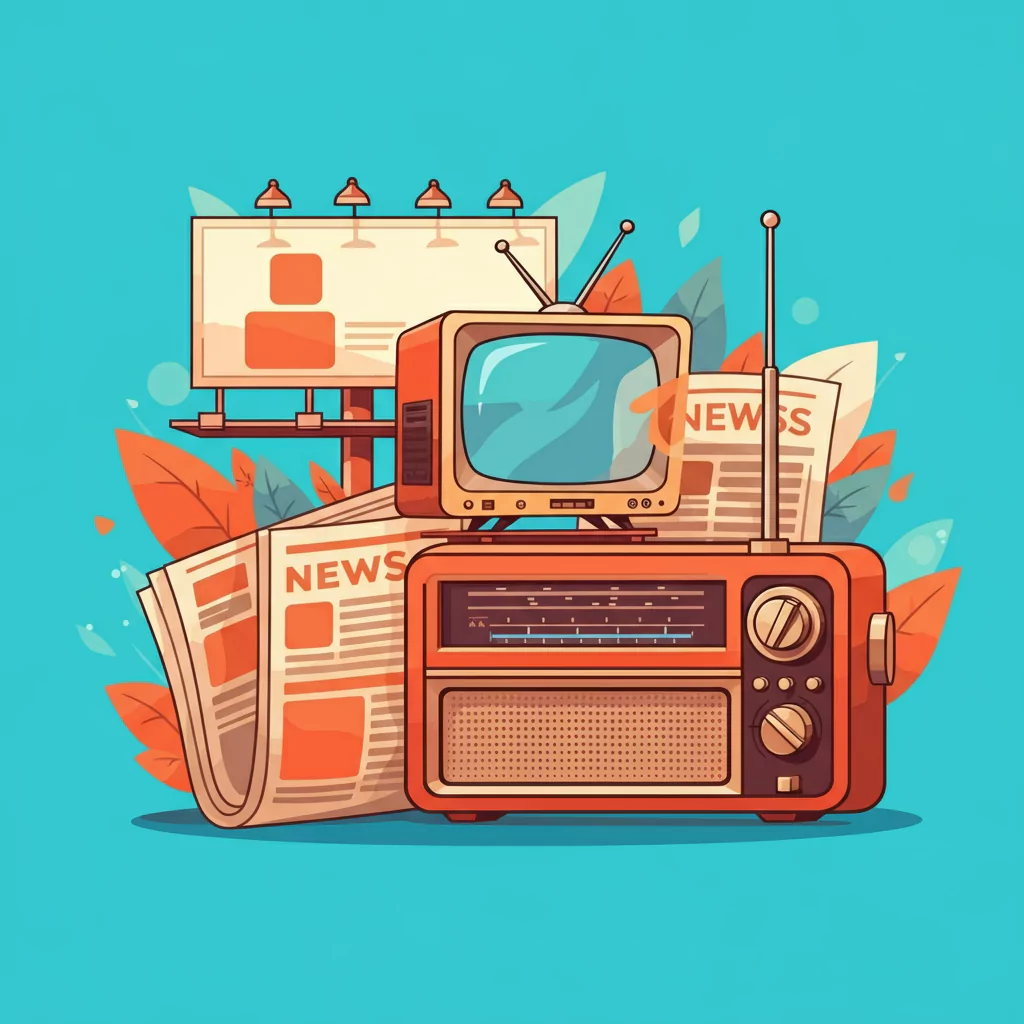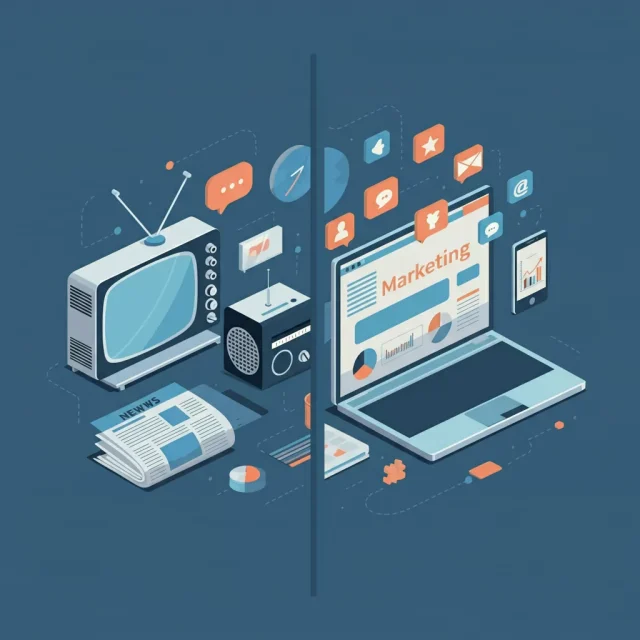Marketing has many faces, and while the term often brings to mind digital strategies like social media ads and email campaigns, traditional marketing is where it all began. But what exactly is traditional marketing? Why does it still matter in a world so heavily influenced by digital media?
This blog takes you through the basics, explores the different forms of traditional marketing, and discusses its relevance for today’s brands.
What Is Traditional Marketing?
At its core, traditional marketing refers to any promotional effort that doesn’t rely on digital channels. Think of methods that have stood the test of time, like TV ads, billboards, and direct mail. These strategies rely on direct, physical means of reaching an audience and work independently of the internet.
Key Characteristics of Traditional Marketing
- Tangible Presence: Traditional marketing materials, such as flyers or magazines, exist physically and often leave a lasting impression.
- Mass Appeal: The approach often targets broad, diverse audiences through widespread channels like radio or television.
- One-way Communication: Traditional marketing is usually non-interactive, meaning it provides information but doesn’t receive real-time feedback from its audience.
- Repetition for Visibility: These tactics often rely on repeated exposure to create brand recall, such as seeing the same ad multiple times on TV or a billboard.
The Different Types of Traditional Marketing
Traditional marketing spans a broad array of techniques. Here are some of the most common types:
1. Print Media
Print media includes newspapers, magazines, brochures, and flyers. It’s one of the oldest forms of marketing and gives brands the opportunity to target specific demographics based on the readership of particular publications.
Example:
A sporting goods store placing an ad in a fitness magazine to attract gym-goers.
2. Broadcast Media
Broadcast media uses platforms like television and radio to communicate messages to a large audience. Radio jingles and catchy TV ads stick in people’s minds, helping brands create a strong presence.
Example:
Remember the jingle for a local car dealership or the memorable Super Bowl commercials? They’re examples of broadcast media in action.
3. Outdoor Advertising
Billboards, posters, and transit ads (like buses and subways) all come under outdoor marketing. These methods offer high visibility, especially in densely populated areas or along busy highways.
Example:
A movie studio is promoting an upcoming blockbuster on a massive billboard in Times Square.
4. Direct Mail
Direct mail involves sending promotional materials, such as flyers, catalogs, or postcards, straight to people’s homes. Personalization is key, as targeting individuals with tailored messages increases engagement.
Example:
A real estate agent sends postcards with market updates tailored to the recipient’s neighborhood.
5. Telemarketing
Telemarketing involves reaching out to potential customers via phone. While often viewed as intrusive, when done right, it can be an effective way to generate leads or close sales.
Example:
A subscription company calling to offer an exclusive deal to previous customers.
6. Event Sponsorship and Experiential Marketing
Hosting or sponsoring event-based activities can create immersive brand experiences. Think of brand stalls at trade shows or a sponsored gala.
Example:
A beverage company is sponsoring a music festival and setting up booths for free sampling.
The Pros and Cons of Traditional Marketing
No marketing approach is perfect, and traditional strategies have their own advantages and challenges.
Benefits of Traditional Marketing
Tangible Impact:
- Physical marketing materials like brochures or billboards have a sense of permanence.
High Reach Potential:
- Broadcast methods like TV and radio reach a massive audience at once.
Brand Recall:
- Repeated exposure increases familiarity, which can build trust over time.
Credibility:
- Traditional media is often perceived as more trustworthy than digital ads. A study found that print ads perform better in terms of ad recall and brand trust compared to online ad formats.
Drawbacks of Traditional Marketing
Cost:
- Traditional methods, especially TV or print ads, can be expensive to produce and distribute.
Harder to Measure ROI:
- Unlike digital marketing, which offers analytics to track engagement, it’s tougher to measure the success of a billboard or newspaper ad.
Limited Interaction:
- Traditional marketing offers one-way communication, lacking real-time feedback from audiences.
Declining Audiences in Some Areas:
- Younger consumers often spend more time online than consuming print or broadcast media.
Does Traditional Marketing Still Matter?
While digital marketing now dominates campaigns, traditional marketing still has a vital role to play in a comprehensive strategy. It works especially well for:
Local Businesses:
- Flyers and billboards are effective in localized regions where digital reach may be overkill.
Targeting Older Demographics:
- Older consumers are more likely to respond to TV, print, and direct mail promotions compared to younger, more digitally savvy audiences.
Brand Awareness:
- High-impact outdoor ads or TV spots aid in making your brand recognizable to a broad audience.
Blending Traditional and Digital Marketing

One of the biggest trends in marketing today is the integration of traditional and digital strategies. By combining both, businesses can enjoy the strengths of each technique for maximum impact.
A Local Restaurant Example:
-
- Combine a billboard with a QR code directing users to your online menu or social media page.
Event Integration:
-
- Enhance event sponsorships by creating hashtag campaigns that attendees can follow online.
This blended approach ensures your message reaches individuals wherever they spend their time.
How to Get Started with Traditional Marketing
If you’re considering leveraging traditional marketing for your business, here are a few actionable steps to start:
Define Your Goals:
- Are you looking to build brand awareness, promote an event, or generate leads? Your goal will shape your strategy.
Know Your Audience:
- Choose methods that match the preferences of your target demographic.
Set Your Budget:
- Traditional campaigns can require substantial investment, so allocate your resources wisely.
Track Results:
- Use methods like unique coupon codes or special URLs to measure the effectiveness of your offline campaigns.
The Future of Traditional Marketing
While digital marketing has taken center stage, traditional marketing remains essential for building credibility and establishing a tangible connection with your audience. When used thoughtfully, it can complement digital efforts for a holistic, impactful strategy.
Don’t dismiss traditional methods as “outdated”—embrace their time-tested effectiveness and use them to support your overall marketing goals.









